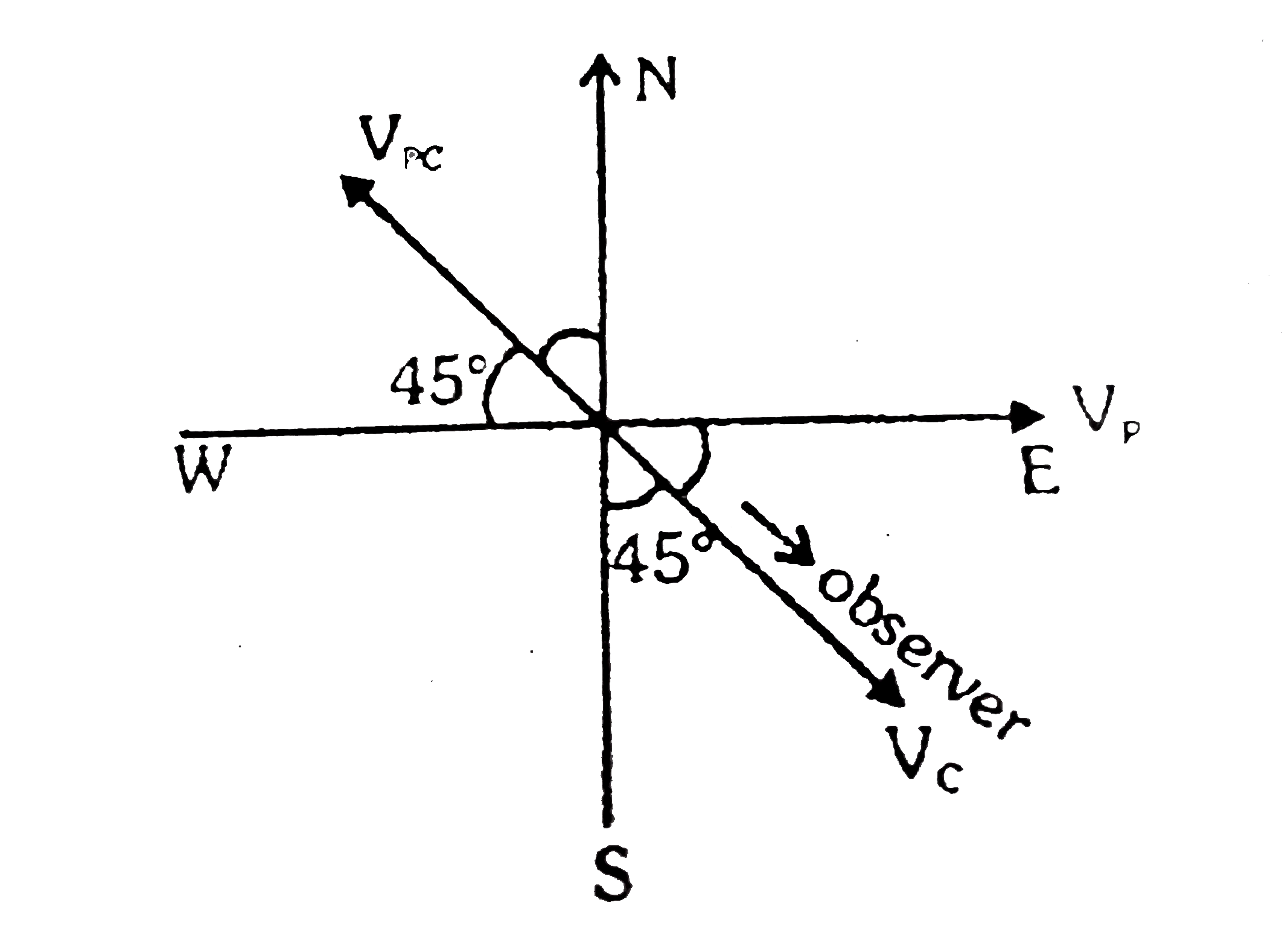When a particle is undergoing motion, the diplacement of the particle has a magnitude that is equal to or smaller than the total distance travelled by the particle. In many cases the displacement of the particle may actually be zero, while the distance travelled by it is non-zero. Both these quantities, however depend on the frame of reference in which motion of the particle is being observed. Consider a particle which is projected in the earth's gravitational field, close to its surface, with a speed of 100√2m/s, at an angle of 45∘ with the horizontal in the eastward direction. Ignore air resistance and assume that the acceleration due to gravity is 10m/s2.
" A third observer (C) close to the surface of the reports that particle is initially travelling at a speed of 100√2m/s making on angle of 45∘ with the horizontal, but its horizontal motion is northward". The third observer is moving in :-
The south-west direction with a speed of 100√2m/s
The south-east direction with a speed of 100√2m/s
The north-west direction with a speed of 100√2m/s
The north-east direction with speed of 100√2m/s
The correct Answer is:B
As observer observes that particle moves north-wards.

Topper's Solved these Questions
- BOOK - ALLENCHAPTER - KINEMATICSEXERCISE - Comprehension#73videos
KINEMATICS
- BOOK - ALLENCHAPTER - KINEMATICSEXERCISE - EXERCISE-04[A]35videos
KINEMATICS
- BOOK - ALLENCHAPTER - KINEMATICSEXERCISE - Comprehension#56videos
KINEMATICS
- BOOK - ALLENCHAPTER - ERROR AND MEASUREMENTEXERCISE - Part-2(Exercise-2)(B)22videos
ERROR AND MEASUREMENT
- BOOK - ALLENCHAPTER - KINEMATICS (MOTION ALONG A STRAIGHT LINE AND MOTION IN A PLANE)EXERCISE - BEGINNER S BOX-78videos
KINEMATICS (MOTION ALONG A STRAIGHT LINE AND MOTION IN A PLANE)
Similar Questions
Knowledge Check
- Question 1 - Select One
When a particle is undergoing motion, the diplacement of the particle has a magnitude that is equal to or smaller than the total distance travelled by the particle. In many cases the displacement of the particle may actually be zero, while the distance travelled by it is non-zero. Both these quantities, however depend on the frame of reference in which motion of the particle is being observed. Consider a particle which is projected in the earth's gravitational field, close to its surface, with a speed of 100√2m/s, at an angle of 45∘ with the horizontal in the eastward direction. Ignore air resistance and assume that the acceleration due to gravity is 10m/s2.
There exists a frame (D) in which the distance travelled by the particle is minimum. This minimum distance is equal to :-A2 kmB1 kmC0 kmD500 m - Question 2 - Select One
The distance travelled by the particle is
A8 cmB2 cmC4 cmDzero - Question 3 - Select One
When a particle is undergoing motion, the diplacement of the particle has a magnitude that is equal to or smaller than the total distance travelled by the particle. In many cases the displacement of the particle may actually be zero, while the distance travelled by it is non-zero. Both these quantities, however depend on the frame of reference in which motion of the particle is being observed. Consider a particle which is projected in the earth's gravitational field, close to its surface, with a speed of 100√2m/s, at an angle of 45∘ with the horizontal in the eastward direction. Ignore air resistance and assume that the acceleration due to gravity is 10m/s2.
The motion of the particle is observed in two different frames: one in the ground frame (A) and another frame (B), in which the horizontal component of the displacement is always zero. Two observers locates in these frames ill agree on :-AThe total distance travelled by the particleBThe horizontal range of the particleCThe maximum height risen by the particleDNone of these
A particle of mass 4 kg is acted upon by steady force of 4 N.Distance travelled by the particle in 4 sec is
View SolutionWhen a particle is undergoing motion, the diplacement of the particle has a magnitude that is equal to or smaller than the total distance travelled by the particle. In many cases the displacement of the particle may actually be zero, while the distance travelled by it is non-zero. Both these quantities, however depend on the frame of reference in which motion of the particle is being observed. Consider a particle which is projected in the earth's gravitational field, close to its surface, with a speed of 100√2m/s, at an angle of 45∘ with the horizontal in the eastward direction. Ignore air resistance and assume that the acceleration due to gravity is 10m/s2.
Consider an observer in frame D (of the previous question), who observes a body of mass 10 kg acelerating in the upward direction at 30m/s2 (w.r.t. himself). The net force acting on this body, as observed from the ground is :-View SolutionIf distance covered by a particle is zero, what can be its displacement ?
View SolutionIf a particle is executing simple harmonic motion, then acceleration of particle
View SolutionA particle moves 3m north , then 4m east and finally 6m south . Calculate the distance travelled and the displacement.
View Solution

